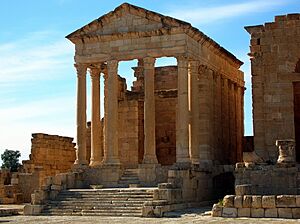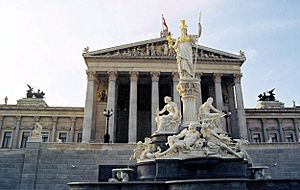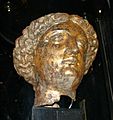Minerva facts for kids
Minerva (also called Menrva by the Etruscans) was a very important Roman goddess. She was known for many things, including wisdom, fairness, laws, winning battles, and helping with arts, trade, and clever plans. She was also a goddess of war.
Minerva's areas of influence included music, poetry, medicine, wisdom, business, weaving, and different crafts. You'll often see her with her special animal, an owl, which showed her connection to wisdom and knowledge. She is usually shown as tall, strong, and wearing armor while holding a spear. As a major Roman goddess, she was highly respected and honored.
Contents
How Minerva Was Born
The story of Minerva's birth is similar to that of the Greek goddess Athena. The powerful god Jupiter fell in love with a titaness named Metis. When Metis was about to have their child, Jupiter remembered a prophecy. It said that his own child would one day overthrow him, just as he had overthrown his father Saturn, and Saturn had overthrown his father Caelus.
Fearing that their child would be a boy and grow stronger than him, Jupiter tricked Metis into turning into a fly and then swallowed her. Inside Jupiter, Metis gave birth to Minerva and even made weapons and armor for her. All this activity inside Jupiter caused him terrible headaches. To stop the pain, Vulcan, the god of fire, used a hammer to split Jupiter's head. From his head, Minerva emerged, fully grown and ready for battle in her armor!
Minerva's Special Items
Minerva is often shown wearing a helmet, which stands for her military strength and smart thinking. Her helmet often had fancy designs, showing her link to art and crafts. She carries a spear, which shows her role as a warrior goddess, and a shield. This shield was often the aegis, a special shield with the head of Medusa on it, symbolizing protection and power.
The owl, known for being wise and having sharp eyesight, was her sacred animal. The olive tree, a sign of peace and good fortune, was also connected to her.
What Minerva Did
Minerva's influence went far beyond just battles. She was the special protector of many crafts and skills. Weaving, pottery, working with metals, and medicine were all under her care. Artists and craftspeople would pray to her for ideas, skill, and success in their work.
She also supported education and learning, which made her very popular among scholars and students. The Romans believed that Minerva guided their studies, helping them to be creative and come up with new ideas.
Minerva in Roman Life

Minerva was very important in Roman society. This is clear from the many temples, festivals, and ceremonies dedicated to her. The most famous temple for Minerva was on the Capitoline Hill in Rome. This was one of Rome's seven hills. Her temple was built next to temples for Jupiter and Juno, forming a powerful group of three gods. This shows how important she was in the Roman pantheon (their group of gods).
This temple was a grand building. Its construction probably started in the 6th century BC. Over Roman history, the temple was rebuilt and improved many times.
The Romans celebrated Minerva with festivals throughout the year. The most important one was the Quinquatrus, a five-day festival held in March. This festival was a time to celebrate crafts and skills. Artisans and students took part in parades and offered gifts to the goddess. The festival included games, competitions, and sacrifices, all to honor Minerva and ask for her blessings.
Minerva in Art and Stories
You can see Minerva everywhere in Roman art and literature. She appears in countless sculptures, mosaics, and paintings. These artworks often show her special items and roles. Her helmet, spear, shield, and owl are common symbols that help people recognize her right away.
Roman writers often mentioned Minerva in their works, highlighting her wisdom, smart plans, and protective nature. Her image even appeared on coins, showing how important she was in Roman society. The way Minerva was shown in art often depended on the reason for the artwork, whether it was to celebrate a military win, honor a craft, or simply show respect.
Minerva's Lasting Impact
Minerva's influence goes far beyond ancient Rome. Her name and qualities have been important throughout history, inspiring artists, writers, and thinkers. The word "Minerva" itself has become a symbol for wisdom, intelligence, and clever thinking.
Interesting facts about Minerva
- The name Minerva comes from an old word meaning "intelligent" or "understanding."
- Minerva is thought to have invented the flute by making holes in boxwood.
- She is shown on coins from different Roman emperors.
- The Seal of California shows the goddess.
- The U.S Military Medal of Honor for the Army, Navy/Marine Corps, and Coast Guard has Minerva in its center.
Related pages
- Menrva - The Etruscan mythology version of Minerva
- Athena - The Greek mythology version of Minerva
Images for kids
-
Mosaic of the Minerva of Peace in the Library of Congress
-
A head of "Sulis-Minerva" found in the ruins of the Roman baths in Bath
See also
 In Spanish: Minerva para niños
In Spanish: Minerva para niños






